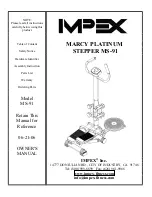
FORM NO. 56043058 Hydro-Retriever™ 3800 / 2042 / BR 1100 -
73
ELECTRICAL SYSTEM
Vacuum Switch (29):
This switch is used to toggle the state of the vacuum motor. Pressing and releasing this switch will alternately turn the vacuum motor on and off.
The indicator
(37)
provides the following status information:
Off
- Vacuum output is off and there is no current flow through the contactor coil and no vacuum motor current sensed.
Green
- Vacuum output is on and there is normal current flow through the contactor coil and normal vacuum motor current sensed.
Flashing yellow
- Either the vacuum motor output is off and there is current flow through the coil or vacuum motor current is sensed (shorted output
driver, control error, shorted contactor, wiring error) or the vacuum motor output is on and there is no current flow through the coil or no vacuum
motor current is sensed (open circuit, open relay coil, open contactor contacts, wiring error or open output driver).
Solution Switch (30):
This switch is used to toggle the state of the solution solenoid. Pressing and releasing this switch will alternately turn the solution solenoid on and
off. The indicator
(28)
provides the following status information:
Off
- Solenoid output is off and there is no current flow through the solenoid coil.
Green
- Solenoid output is on and there is normal current flow through the solenoid coil.
Flashing yellow
- Either the solenoid output is off and there is current flow through the coil (shorted output driver or control error) or the solenoid
output is on and there is no current flow through the coil (open circuit, open solenoid coil, or open output driver).
Dust Control Switch (39):
This switch is used to control the outputs to the pre-sweep and dust control. Pressing and releasing this switch will activate these outputs in the
following order.
NOTE 1: This switch will only function if the pre-sweep option has been previously enabled.
NOTE 2: Upon entering “Service Test
Mode” you are at step one. Press this switch and observe step 2.
The order of output activation is as follows:
1 - pre-sweep off, dust control off
2 - pre-sweep on, dust control off
3 - pre-sweep off, dust control off
4 - pre-sweep off, dust control on
5 - pre-sweep off, dust control off
6 - pre-sweep on, dust control on
The pre-sweep and dust control indicators
(40 & 41)
provide the following status information:
Off
- output is off and there is no current flow through the contactor coil.
Green
- output is on and there is normal current flow through the contactor coil.
Flashing yellow
- output is off and there is current flow through the coil (shorted output driver, control error, wiring error) or the output is on and
there is no current flow through the coil (open circuit, open relay coil, wiring error or open output driver).
NOTE: The control does not monitor the current flow in the pre-sweep motors or the dust control motor. Only the contactor currents are monitored.
Side Broom Control Switch (51):
This switch is used to control the outputs to the side broom. Pressing and releasing this switch will activate these outputs in the following order.
NOTE: Upon entering “Service Test Mode” you are at step one.
Press this switch and observe step 2.
The order of output activation is as follows:
1 - side broom off, up position
2 - side broom on, up position
3 - side broom off, up position
4 - side broom off, down position
5 - side broom off, up position
6 - side broom on, down position
The side broom indicator
(50)
provides the following status information:
Off
- output is off and there is no current flow through the contactor coil.
Green
- output is on and there is normal current flow through the contactor coil.
Flashing yellow
- output is off and there is current flow through the coil (shorted output driver, control error, wiring error) or the output is on and
there is no current flow through the coil (open circuit, open relay coil, wiring error or open output driver).
NOTE: The control does not monitor the current flow in the side-broom motors. Only the contactor currents are monitored.
SERVICE TEST MODE (CONTINUED)
revised 12/02
















































